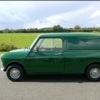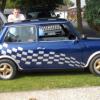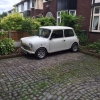Probably want a good thirty to fifty miles to settle them in. Pads usually recommend a hundred plus miles, avoiding heavy braking.
This from EBC:
- "Use brakes with minimal pressure for first 100 miles from urban speeds of 30-50 mph only.
- Drive a further 250 miles using slightly increased brake pressure and load UNLESS in an emergency in which case apply brake as hard as required.
- Look for a full width contact across the pad depth( rotor braking band) from the outer edge of the disc to the inner and if not achieved allow a further 100-200 miles steady driving. You will see a blue-ish band evidencing contact across the rotor face. Until this band goes from the outer to the inner edges of the brake disc/rotor the pads have NOT yet fully seated. When installing new rotors, reduced width banding is quite possible due to various tolerances and slight misalignments in the vehicle chassis and is NOT a warranty defect or a reason to remove and inspect brakes. Many European cars have SINGLE PISTON CALIPERS and these tend to “Flair” open and cause the contact band described above only to be seen at the outer edge of the disc/rotor and work its way inwards taking up to 1000 miles to do so.
- After full width contact band is attained make a further 10 stops from 60 mph to 10 mph in succession with a deliberate attempt to get the brakes hot. Some smells may occur even slight smoke during this final heat up stage of the pads in early life. Then coast the vehicle for a mile to allow discs to cool. Do not pull up and park vehicle with brake excessively hot. You must try to get the discs down to below 60-80 degrees C temperature before parking the vehicle.
- When parked let brakes cool to a final cool-to-touch point. Before touching discs splash a few tiny drops of water onto the disc to asses its temperature to avoid burning fingers. If the water spots cause a “hiss” you have parked up too soon and should go out and drive slowly allowing the brakes to cool further.
NEW DISCS TAKE LONGER TO BED IN
- Fully bedding new pads to decent condition worn discs/rotors may take only 200-300 miles but when new discs are fitted at the same time bed in times to achieve outer to inner edge contact ( full width blue-grey contact band as mentioned under point 4 above ) can be as long as 800-1000 miles due to extra components needed to be aligned to the vehicle. To Short cut this you can ( and EBC recommend should) have EVEN NEW DISCS Pro Cut Lathe aligned to your vehicle. This process removes only microns of new disc material and shortens bed in time by 75% of the time it COULD take giving you better brakes faster and avoiding hot spotting and pad glazing."
Allrighty then, I'll have a look into getting them lathe aligned if that's available anywhere near where I live, otherwise it's apparently just a matter of driving it to settle them in

Are you comparing the brakes to a modern car? Even discs on a mini sent as effective as modern brakes.
Do you have a servo?
Nope, no servo. Seemed like too big of a hassle ti get one for a LHD Mini without going with single line brakes, and apparently they're not really needed anyway on a Mini :)
Thanks everyone for the replies! Guess I'm off to driving it some more

![]()




















